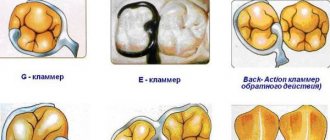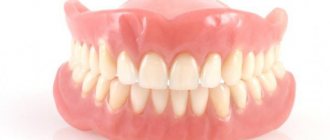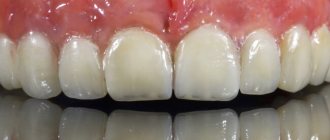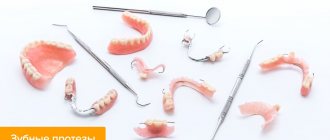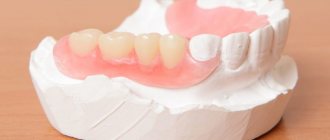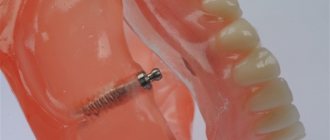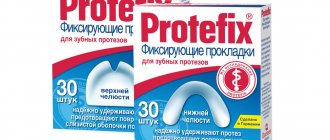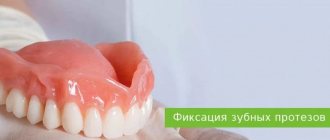When it comes to “traditional” prosthetics (without the participation of implants), the issue of installing temporary structures is often resolved “by default” (doctors sometimes say: “Don’t worry, we won’t let you go without a tooth”). Making a permanent crown may take time, and during this period aesthetic (at least) restoration is important. The doctor makes a temporary crown from a polymer material directly in his office, and this is how the aesthetic problem is solved.
When it comes to temporary prosthetics in the case of dental implantation, nuances arise. It's all about the support: the situation does not always allow for implantation with immediate loading. “Classical” implantation is also called “two-stage”:
- Stage 1 is the introduction of the implant itself and its engraftment, which takes several months.
- Stage 2 – orthopedic (the doctor installs the abutment and fixes the prosthesis).
During the first stage, the implant is unstable, so it cannot be loaded with a crown. What options are available to hide a missing tooth after implantation?
Why are temporary dentures needed?
The main purpose of a temporary prosthesis is to restore chewing function and an attractive appearance; the structures are also designed for the following purposes:
- formation of a prosthetic bed;
- preventing the displacement of healthy teeth;
- helps to reduce the period of adaptation to a permanent prosthesis;
- while wearing it, the correct bite is maintained;
- prevents inflammation and irritation of the gums;
- protects soft tissues from any damage;
- promotes uniform load distribution.
Depending on the situation, temporary removable dentures can be installed for 1-6 months. The maximum wearing period can be up to 5 years, but subject to careful use and proper oral care. Prosthetics are recommended when getting used to implants, re-prosthetics and changing teeth in children.
Call us or 8 (926) 100-10-10
The process of addiction
Getting used to wearing temporary dentures depends on the individual’s capabilities.
For some people, this takes a few hours. However, there are also situations when the patient absolutely cannot come to terms with the presence of a foreign element in his mouth.
There should be no pain after temporary prosthetics.
Sometimes patients are concerned about changes in the amount of saliva secreted (increase or decrease). Typically, such a violation indicates poor-quality prosthetics.
To speed up the adaptation to the use of a prosthesis, doctors usually recommend using a special (intraoral) massage.
It is done like this: the index finger clamps the artificial tooth, and the thumb performs massaging movements of the gums (up and down movements, pressing, spiral movement).
Temporary removable dentures
The price of prosthetics is affordable, the designs are also called “butterflies”, the features include the following:
- plastic is used for manufacturing;
- easy maintenance, since the structures can be removed at any time;
- there is no need to remove dentures at night;
- fastening is performed without grinding the teeth;
- Wearing period is from 3 to 4 months.
Worth knowing! When using acrylic plastic, the patient may experience breakage of the clasps.
Which is the best method to choose?
There is an alternative to dental prosthetics using implants, and for those who, due to contraindications or other reasons, cannot undergo implantation, this is a real salvation. And in each individual case, a method is selected based on specific conditions, the nature of the clinical picture, the requirements and capabilities of the patient.
But still, when choosing, it is necessary to take into account that implantation today is essentially the only method that provides complete restoration of the functionality of the dental system, including stopping bone atrophy. Perhaps a full-fledged alternative to dental implantation will appear in the near future, but for now it does not exist - all methods of prosthetics without implantation have disadvantages and do not ensure the transfer of chewing load to the bone, which causes degradation of the jawbone, gradual displacement and destruction of the remaining teeth.
Fixed temporary dentures for front teeth
The plastic crown is fixed with non-permanent cement; the structure can be removed at any time if necessary. Fastening can be performed on a ground tooth, which will later be used as a support for a permanent prosthesis. The entire restoration process is carried out in one visit to the dentist for 2-3 hours.
If you have any questions about the prices and timing of installing temporary dentures on your front teeth, you can always contact our specialists for advice by phone or through the feedback form.
Is it necessary to insert a tooth after extraction?
Many patients do not even ask questions about how many days after tooth extraction they can get a crown or dentures. But in vain. Even a short-term absence of a tooth in the jaw row is fraught with serious consequences:
- displacement of adjacent units and teeth of the opposite jaw towards the empty space;
- jaw deformation, malocclusion;
- improper redistribution of chewing loads, gastrointestinal problems;
- deterioration of diction, the appearance of complexes due to aesthetics and speech.
The longer the interval between removal and prosthetics, the more serious the orthodontic defects and the more expensive the treatment.
What happens if you refuse to install temporary dentures?
The main purpose of a temporary prosthesis is to restore the dentition in the oral cavity until a permanent prosthesis is ready or an implant is installed.
For various reasons, this process can take a long time - from two to three weeks or more. During this period, when one or more teeth are missing, there is a high risk of complications:
- pathological change in bite;
- rapid destruction of healthy teeth due to increased load;
- a change in the position of the teeth towards a “gap” - the teeth lose not only their support point, their attachment in the sockets weakens, and all this leads to significant deformations of the dentition;
- without a prosthesis, the exposed area of the jaw will not receive the necessary load during the chewing process, which will provoke changes in the bone tissue - it will become porous, decrease in volume and will be unsuitable for prosthetics;
- The part of the mucosa not protected by the prosthesis is prone to injury when chewing.
And of course, while the prosthesis is being made, the patient should not experience psychological discomfort and be ashamed of his smile. Missing teeth, especially front teeth, is always unpleasant. Installing a temporary denture allows you to safely avoid stress and social maladjustment.
Temporary dentures are much cheaper than permanent ones, and there is no point in saving on them.
Total prosthetics after tooth extraction
The situation is considered separately - the removal of all teeth immediately before prosthetics. In this case, the patient is faced with complete adentia, which requires emergency treatment.
Option two:
- Removable prosthetics - quickly, inexpensively, with guaranteed atrophy of bone tissue subsequently, frequent replacement of the prosthesis and inconvenience of wearing the product.
- Implantation with installation of a fixed prosthesis - according to all-on-4 or all-on-6 protocols. The essence of the treatment is the installation of a fixed number of dental implants and the attachment of a full denture prosthesis to them. Implantation of 4 or 6 artificial roots is performed on the day of removal. An impression is immediately made, from which artificial teeth are made in a dental laboratory. The longest waiting period is 3 days, after which the patient receives a full-fledged jaw capable of withstanding all physiological loads.
Types of temporary dentures
Temporary prostheses are divided into the following types according to their area of application:
- Immediate dentures
This is one of the most affordable types of structures, with which you can restore 1-3 lost teeth in a row. They are only used when defects are enabled.
Immediate dentures are also called butterflies. The resemblance to a butterfly is given to the prosthesis by rounded clasp hooks resembling wings. With the help of these hooks, the immediate denture is securely fixed and held on healthy teeth.
The “butterfly” is a removable design that the patient can put on and take off independently. This guarantees an appropriate level of hygiene while wearing the prosthesis.
- Nylon dentures
This is a more versatile option. Nylon dentures are used for inclusionary and terminal defects, to restore an area of the jaw or in the complete absence of teeth.
Nylon dentures are also removable structures. They are fixed using suction cups or special gels and creams, which are recommended by the attending physician.
- Temporary crowns
If the tooth is not completely destroyed or looks unsightly, a crown is installed on it after grinding. And while the permanent prosthesis is being made, a temporary crown is used.
This is a permanent temporary prosthesis that solves the following problems:
- eliminates the aesthetic defect associated with the unsightly appearance of the tooth;
- protects ground teeth from adverse effects and further destruction.
The temporary crown is installed on special temporary cement so that it can be easily removed without damaging the stump.
Crown instead of an extracted tooth - implantation
Implantation is a modern solution for partial and complete adentia. This is what doctors recommend to patients, and there are many reasons for this:
- complete replacement of a lost tooth - not only the upper part, but also the root system;
- restoration of chewing and other functions - after prosthetics, the patient is not limited in the choice of menu, and the quality of speech does not suffer;
- aesthetics - both the crown itself and the artificial gum contour, if present, look natural;
- preservation of bone tissue - bones experience full load, which eliminates atrophy and degradation of bone structures;
- speed of prosthetics - some protocols allow you to restore a tooth immediately after removal.
Implantation options:
- Classic two-step protocol. After removal, the doctor waits for complete healing of the gums and restoration of soft and bone tissues. Then he installs the implant and, after its complete engraftment (4-6 months), places an artificial crown or bridge on the implants without damaging neighboring units. The treatment is long and is recommended for patients who, immediately after extraction, were unable to replace their teeth with prosthetics - the socket has healed, and the tissues have partially atrophied. It is possible to speed up treatment using a two-stage protocol. Premium dental implants Nobel, Strauman take root in 2-4 months, which reduces the period of prosthetics by half.
- One-stage implantation protocol. When a tooth is removed, the patient is immediately implanted with an implant, a gum former or a full-fledged temporary crown. Such treatment requires removal by an experienced implant surgeon, as well as preliminary examination to reduce risks.
- One-stage implantation protocol. It completely eliminates the question of when a tooth can be replaced with a prosthetic after extraction, as it combines all three stages of treatment. The doctor performs an extraction, places a dental implant and immediately loads it with a crown. The patient simply replaces the damaged tooth with a new artificial one, which significantly speeds up the recovery process.
Preparation and installation of temporary dentures
Installation of temporary prostheses helps solve aesthetic and functional problems while a permanent prosthesis or implantation is being manufactured.
But in order for the prosthesis to meet your expectations, you need to properly prepare for its installation. To do this, you will need to sanitize the oral cavity, eliminate inflammatory processes in the mucous membrane and solve all problems with diseased teeth.
If temporary dentures are recommended by your prosthodontist, do not underestimate their importance to your health and ignore the installation.
When are alternative methods required?
There are absolute and relative contraindications for implantation. Absolute ones are those that make implantation impossible in principle. These include:
- various pathologies of bone tissue,
- diseases of the immune system (HIV, AIDS, etc.),
- autoimmune diseases,
- oncology,
- severe infectious diseases (tuberculosis),
- nervous and mental diseases,
- blood diseases (especially bleeding disorders),
- children's age (up to 18 years).
Relative contraindications include problems that are temporary or can be corrected and, after restoration of health, allow implantation. These are states such as:
- pregnancy and lactation,
- rehabilitation period after heart attack and stroke,
- acute viral diseases,
- dental diseases (caries, pulpitis, periodontitis, stomatitis, etc.),
- exacerbation of chronic diseases,
- dysfunction of the mandibular temporal joint,
- severe atrophy of the jaw bone,
- malocclusion,
- alcoholism and drug addiction,
- poor oral hygiene.
If you are unlucky and you are one of those who are contraindicated for dental implants (at least in the next few years), then you have to look for alternative methods.
